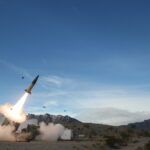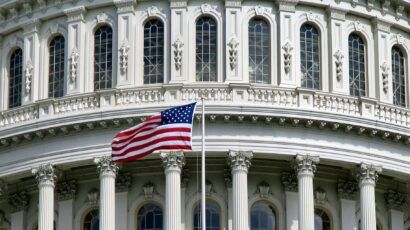Missile defense in Japan
By Masako Toki | January 16, 2009
Japanese security policy is at a crossroads, shifting from a traditional pacifist security policy to a more assertive security policy. As part of this shift, Tokyo is steadily moving toward the deployment of a more robust missile defense system, which the Japanese government doesn’t think contradicts the country’s “exclusively defensive defense” policy anyway. And while the debate about U.S. missile defense installations in Eastern Europe remains contentious, in East Asia, political debate about missile defense installations in Japan seems to be fading away.
Under Prime Minister Junichiro Koizumi, U.S.-Japanese security ties were enhanced post-9/11. His friendship with President George W. Bush also augmented the two countries’ bond. As such, it was under Koizumi that Japan officially decided to deploy missile defense in collaboration with the United States.
In fact, Koizumi made missile defense a cornerstone of the country’s security policy. He wasn’t alone in this thinking; many Japanese government officials perceive missile defense as a more realistic option in responding to regional threats such as North Korea’s nuclear and missile programs. In addition, Japan’s 2004 National Defense Guidelines, for the first time, stated concerns over China’s military modernization.
History of missile defense in Japan
U.S.-Japanese cooperation on missile defense dates back to the 1980s and the Reagan administration’s Strategic Defense Initiative (SDI). At that time, Japan’s participation in SDI was merely symbolic of U.S.-Japanese security cooperation and helpful to mitigate economic and trade disputes with Washington.
This changed in August 1998 when North Korea tested its Taepodong-1 ballistic missile. Even for the Japanese people, who are generally considered pacifists post-World War II, the Taepodong-1 flying over their heads was an alarming wake-up call. Immediately afterward, Tokyo joined Washington in cooperative research and development of a ballistic missile defense system.
On the basis of seemingly positive results of missile defense tests and the U.S. decision to deploy an initial national missile defense capability in December 2002, the Japanese government determined that ballistic missile defense had high technological feasibility. In addition, the revelation that North Korea had continued its work on nuclear weapons development and Pyongyang’s subsequent withdrawal from the NPT in 2003 convinced Tokyo to officially acquire a ballistic missile defense capability. Thus, on December 19, 2003, it issued the cabinet decision “On Introduction of Ballistic Missile Defense System and Other Measure.” Ever since, establishing a robust missile defense system has been a top national security priority.
To implement its new agenda, Tokyo altered its National Defense Program Guidelines in 2005 to indicate that the country’s Three Principles on Arms Export and related provisions could be modified as necessary for the deployment of ballistic missile defense. The “Three Principles,” a hallmark of Japan’s pacifism policy, long barred Tokyo from jointly developing and producing weapons or transferring weapon parts to foreign countries, including the United States.
Tokyo’s surprisingly determined and quick adoption of these decisions in order to be ready for the actual deployment of ballistic missile defense seem to be influenced by North Korea’s actions. In particular, since North Korea’s July 2006 missile launches, which ended its 1999 missile test moratorium, and Pyongyang’s October 2006 nuclear test, Tokyo has accelerated its missile defense deployment.
Japan’s current missile defense capabilities
As of January, Tokyo has deployed a multilayered missile defense system that consists of sea-based midcourse missile defense (the Aegis ballistic missile defense system); and ground-based terminal phase missile defense (Patriot Advanced Capabilities-3, or PAC-3). With the accelerated process, a PAC-3 installment in the Tokyo Metropolitan area has been completed. By March 2011, PAC-3 missiles will be deployed at 16 fire units around Japan’s major cities.
The Aegis system features a three-stage missile (SM-3) with a range of 1,000 kilometers designed to intercept a short- to intermediate-range ballistic missile in outer space. At its first flight test in December 2007, the SM-3 launched from Kongo, a Japanese Aegis ship, and detected, tracked, and destroyed a mock missile that resembled North Korea’s Nodong outside the atmosphere at an altitude of approximately 100 miles. With its mission accomplished, Kongo was deployed at Japan’s Air Self Defense Force (MSDF) Sasebo base in Nagasaki on January 4, 2008.
As the first country other than the United States to succeed in intercepting a mock missile with the Aegis system, Japan might have been overconfident in its technical feasibility. Moreover, at its first test-firing of the PAC-3 interceptor, MSDF successfully shot down a mock ballistic missile at White Sands Missile Range in New Mexico last September. This sequence of successful tests might have brought somewhat more optimistic prospects to Japan’s defense ministry. Therefore, the failure of a second Aegis test in November significantly disappointed both U.S. and Japanese missile defense proponents. While officials said the failure won’t affect the program’s future–The Ministry of Defense plans to deploy four Aegis-equipped destroyers by March 2011–some setbacks will be unavoidable.
Impediments to missile defense in Japan
“Basic Space Law.” Japan’s long-standing, self-imposed restriction on the military use of space has impeded it from enhancing its missile defense capabilities. However, in August 27, a new law, the “Basic Space Law,” entered into force, lifting the ban on Tokyo’s use of space for defensive purposes. Thirty years earlier, when Japan’s Space Agency was established, the Diet unanimously adopted a resolution committing the country only to using space for peaceful purposes, which has been interpreted as non-military.
The Basic Space Law changed that interpretation to nonaggressive, meaning the MSDF now can manufacture, possess, and operate its own satellites to support military operations such as ballistic missile defense. Thus, the MSDF plans to procure reconnaissance satellites, early warning satellites, and tracking and communications satellites–all areas in which Japan had been relying on the United States. (See “Japan Enters New Space Age.”) For instance, it was the U.S. Defense Support Program satellites that detected the North Korean missile launches in July 2006.
The Japanese Constitution. Under the current Japanese government’s interpretation of Article 9 of its Constitution, Japan’s participation in collective self-defense is prohibited, as is using missile defense capabilities to defend a third country–even an ally such as the United States.
Therefore, former Prime Minister Shinzo Abe, a strong advocate of changing Article 9, formed the Council on Reconstruction of a Legal Basis for Security in April 2007 to provide recommendations on the right of collective self-defense. “Whether it is appropriate for Japan to use its missile defense to intercept ballistic missiles targeting the United States” was one of four scenarios he tasked the council to answer.
The council was supposed to submit recommendations to the Cabinet by September 2007, but after the devastating defeat of Abe’s ruling party in the upper house election in July 2007 and his abrupt resignation two months later, the council’s members delayed making their recommendations. Abe’s successor, Yasuo Fukuda, wasn’t as enthusiastic about changing the constitutional interpretation. So even though the council submitted its recommendations stating that Japan should have the right to exercise collective self-defense last June, nothing has changed. Taro Aso, the country’s third prime minister in two years, is more supportive of the right to collective self-defense, which might revitalize debate over the issue.
Technologically, Japan currently doesn’t have the capability to shoot down a missile heading toward the United States even if it legally could. But the two countries are currently developing SM-3 Block II A missiles that could potentially intercept intercontinental ballistic missiles. (See “Japan Test Fires Its First Raytheon-Built Standard Missile-3.”) As technological capabilities improve to intercept long-range ballistic missiles, the argument that Japan isn’t allowed by its constitutional interpretation to shoot down a missile heading toward the United States might be perceived as unacceptable.
Technical limitations. Although both the Japanese and U.S. governments have highlighted successful flight tests, all flight intercept tests have been conducted under highly structured conditions with information about the missile attack. In a real missile launch, it’s highly unlikely that the launch location, timing of launch, and flight trajectories will be known, making it almost impossible to predict the percentage of success of an intercept in a real-world attack. (See “Technical Realities: National Missile Defense Deployment in 2004.”)
The Japanese people. The socio-cultural reticence in Japan to any military engagement hasn’t made the country’s populace fully tolerant of missile defense. Nevertheless, the recent threats from North Korea have dimmed opposition. A 2006 public opinion poll conducted by the Cabinet Office indicated that 56.6 percent of respondents supported missile defense; similarly, a Yomiuri-Gallup public opinion poll [in Japanese] conducted in December 2006 showed that 60 percent of respondents supported it.
For those against it, cost seems to be a primary reason why. According to the Ministry of Defense, the missile defense program is estimated to cost Japan $7.4 billion to $8.9 billion through 2012. And since Tokyo plans to pursue still more advanced technologies, costs are likely to increase.
China’s response
Regionally, China has been disturbed by the accelerated progress of the U.S.-Japanese missile defense cooperative. Specifically, China is worried that U.S.-Japanese missile defense could thwart Beijing’s limited nuclear deterrent, encourage Japanese militarization, protect Taiwan, and trigger a regional arms race. Chinese opposition to the U.S.-Japan missile defense cooperation isn’t as vehement as that of Russia to the U.S. missile defense deployment in Eastern Europe, but if China perceives that the missile shield will shift the balance of power in the region, its opposition will intensify.
Future prospects for missile defense in Japan
The current security environment in East Asia and the Bush administration’s interest in missile defense have helped bring the U.S.-Japanese missile defensive cooperative to where it stands today. That said, President-elect Barack Obama has a different view on missile defense; moreover, he has repeatedly stated that strengthening the nonproliferation regime should be a priority. Thus, it’s likely that changes in U.S. security priority will alter Japanese missile defense plans somewhat. Nonetheless, Japan’s already scheduled system deployment date of 2011 probably will be met.
More generally, a robust Japanese missile defense capability isn’t conducive to sustainable peace in East Asia. That’s why it’s particularly important that Japan and the United States avoid building a structure that looks confrontational to China, which would obviously decrease stability in the region. Therefore, President-elect Obama should shift U.S.-Japanese security cooperation to matters of arms control and nonproliferation while inviting other countries in the region such as China to join in this endeavor.
Together, we make the world safer.
The Bulletin elevates expert voices above the noise. But as an independent nonprofit organization, our operations depend on the support of readers like you. Help us continue to deliver quality journalism that holds leaders accountable. Your support of our work at any level is important. In return, we promise our coverage will be understandable, influential, vigilant, solution-oriented, and fair-minded. Together we can make a difference.
Topics: Nuclear Weapons, Opinion















